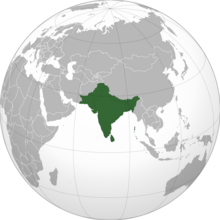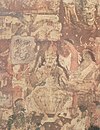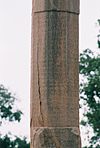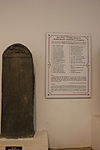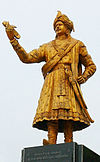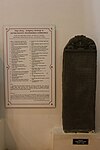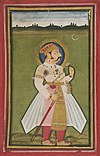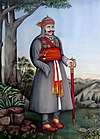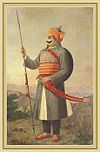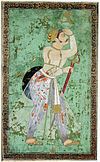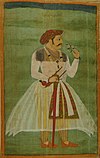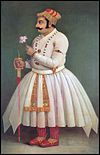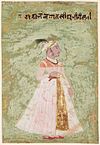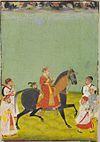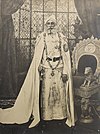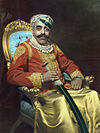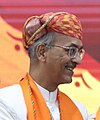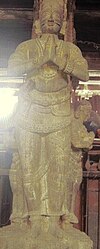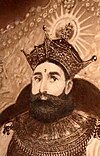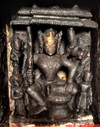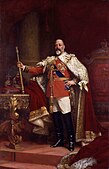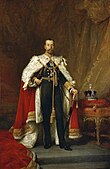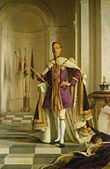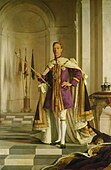This article is a list of the various dynasties and monarchs that have ruled in the Indian subcontinent and it is one of several lists of incumbents .
The Indian subcontinent , the main centre of Indian culture The earliest Indian rulers are known from epigraphical sources found in archeological inscriptions on Ashokan edicts [ 1] [ 2] Sanskrit literature , Jain literature and Buddhist literature in context of literary sources . Archaeological sources include archeological remains in Indian subcontinent which give many details about earlier kingdoms, monarchs, and their interactions with each other.
Early types of historic documentation include metal coins with an indication of the ruler, or at least the dynasty , at the time. These Punch-marked coins were issued around 600s BCE and are found in abundance from the Maurya Empire in 300s BCE. There are also stone inscriptions and documentary records from foreign cultures from around this time. The main imperial or quasi-imperial rulers of North India are fairly clear from this point on, but many local rulers, and the situation in the Deccan and South India has less clear stone inscriptions from early centuries. Main sources of South Indian history is Sangam Literature dated from 300s BCE. Time period of ancient Indian rulers is speculative, or at least uncertain.
Kingdom of Magadha
List of monarchs of Magadha
Kingdom of Kashmir
List of monarchs of Kashmir
Kings of Gandhara
List of Kuru kings
Haiheyas
Sahasrajit
Satajit
Mahahaya, Renuhaya and Haihaya (the founder of Haihaya Kingdom). (Contemporary to Suryavanshi king Mandhatri)
Dharma was the son of Haihaya.
Netra
Kunti
Sohanji
Mahishman was the founder of Mahishmati on the banks of River Narmada.
Bhadrasenaka (Bhadrasena) (Contemporary to Suryavanshi king Trishanku )
Durmada (Contemporary to Suryavanshi king Harischandra)
Durdama
Bhima
Samhata
Kanaka
Dhanaka
Krtavirya, Krtagni, Krtavarma and Krtauja. (Contemporary to Suryavanshi king Rohitashva )
Sahasrabahu Kartavirya Arjuna was the son of Krtavirya who ruled 88 years and was finally killed by Lord Parashurama .
Jayadhwaja, Vrshabha, Madhu and Urujit were left by Parshurama and 995 others were killed by Lord Parashurama. Pajanya was adopted by Kroshta king Devamidha
Talajangha (Contemporary to Suryavanshi king Asita)
Vithihotra (Contemporary to Suryavanshi king Sagara)
Madhu
Vrshni Pradyota dynasty
Kings of Videha
Kings of Kalinga
Kings of Kosala:[ 3]
Kings of Panchala:
Rishin
Brihadbhanu, (son of Brihadvasu)
Brihatkaya
Puranjaya
Riksha
Bramhyaswa
Aramyaswa
Mudgala, Yavinara, Pratiswan, Maharaja Kampilya - (founder of Kampilya capital of Panchala Kingdom )
Sranjaya, (son of Aramyaswa)
Dritimana
Drdhanemi
Sarvasena, (founder of Ujjain Kingdom )
Mitra
Rukmaratha
Suparswa
Sumathi
Sannatimana
Krta
Pijavana
Somadutta
Jantuvahana
Badhrayaswa
Brihadhishu
Brihadhanu
Brihadkarma
Jayaratha
Visvajit
Seinyajit
Nepavirya, (after this King's name the country was named Nepaldesh)
Samara
Sadashva
Ruchiraswa
Pruthusena
Prapti
Prthaswa
Sukrthi
Vibhiraja
Anuha
Bramhadatta II
Vishwaksena
Dandasena
Durmukha
Durbuddhi
Dharbhya
Divodasa
Sivana I
Mitrayu
Maitrayana
Soma
Sivana II
Sadasana
Sahadeva
Somaka, (Somaka's eldest son was Sugandakrthu and youngest was Prishata. But in a war all sons died and Prishata Survived and became the king of Panchala)
Prishati , (son of Somaka)Drupada , (son of Prishata)Dhrishtadyumna , (was the son of Drupada, Draupadi and Shikhandi were the daughters of Drupada)Keśin Dālbhya Pravahana Jaivali Achyuta , (last known ruler of Panchala Kingdom which was defeated in c. 350 CE by Gupta ruler Samudragupta .)
Kings of Anga:
Kings of Kamboja:
Rulers of Shakya:
Later Shakya Republic was conquered by Virudhaka of Kosala .
Ancient and early medieval Southern Indian dynasties
Early Pandyans
Koon Pandiyan - (Earliest Known Pandyan king) Nedunj Cheliyan I (Aariyap Padai Kadantha Nedunj Cheliyan) , he was mentioned in legend of Kannagi Pudappandiyan
Mudukudumi Paruvaludhi
Nedunj Cheliyan II (Pasumpun Pandiyan) Nan Maran
Nedunj Cheliyan III (Talaiyaalanganathu Seruvendra Nedunj Cheliyan)
Maran Valudi
Musiri Mutriya Cheliyan
Ukkirap Peruvaluthi
Sundara Pandyan I
Vira Pandyan I
Vira Pandyan II
Amarabhujanga Tivrakopa
Jatavarman Sundara Chola Pandyan
Maravarman Vikrama Chola Pandyan
Maravarman Parakrama Chola Pandyan
Jatavarman Chola Pandya
Seervallabha Manakulachala (1101–1124)
Maaravaramban Seervallaban (1132–1161)
Parakrama Pandyan I (1161–1162)Kulasekara Pandyan III
Vira Pandyan III
Jatavarman Srivallaban (1175–1180)
Jatavarman Kulasekaran I (1190–1216)
During the 15th century, the Pandyans lost their traditional capital city Madurai because of the Islamic and Nayaks invasion, and were forced to move their capital to Tirunelveli in southern Tamilakam and existed there as vassals.
Cataiyavarman Parakrama Pandyan (1422–1463)
Cataiyavarman III Kulasekara Pandyan (1429–1473)
Azhagan Perumal Parakrama Pandyan (1473–1506)Kulasekara Pandyan (1479–1499)
Cataiyavarman Civallappa Pandyan (1534–1543)
Parakrama Kulasekara Pandyan (1543–1552)
Nelveli Maran (1552–1564)
Cataiyavarman Adiveerama Pandyan (1564–1604)
Varathunga Pandyan (1588–1612)
Varakunarama Pandyan (1613–1618)
Kollankondan (1618–1650)
Ancient Chera kings
Kongu Cheras (c. 400–844 CE)
Makotai Cheras
Venadu Cheras (Kulasekharas) (c. 1090–1530 CE):
Rama Kulasekhara (1090–1102)Kotha Varma Marthandam (1102–1125)
Vira Kerala Varma I (1125–1145)
Kodai Kerala Varma (1145–1150)
Vira Ravi Varma (1145–1150)
Vira Kerala Varma II (1164–1167)
Vira Aditya Varma (1167–1173)
Vira Udaya Martanda Varma (1173–1192)
Devadaram Vira Kerala Varma III (1192–1195)
Vira Manikantha Rama Varma Tiruvadi (1195- ?)
Vira Rama Kerala Varma Tiruvadi (1209–1214)
Vira Ravi Kerala Varma Tiruvadi (1214–1240)
Vira Padmanabha Martanda Varma Tiruvadi (1240–1252)
Ravi Varma (1252–1313)
Vira Udaya Martanda Varma (1313–1333)
Aditya Varma Tiruvadi (1333–1335)
Vira Rama Udaya Martanda Varma Tiruvadi (1335–1342)
Vira Kerala Varma Tiruvadi (1342–1363)
Vira Martanda Varma III (1363–1366)
Vira Rama Martanda Varma (1366–1382)
Vira Ravi Varma (1383–1416)
Vira Ravi Ravi Varma (1416–1417)
Vira Kerala Martanda Varma (1383)
Chera Udaya Martanda Varma (1383–1444)
Vira Ravi Varma (1444–1458)
Sankhara Sri Vira Rama Martanda Varma (1458–1468)
Vira Kodai Sri Aditya Varma (1468–1484
Vira Ravi Ravi Varma (1484–1503)Martanda Varma, Kulasekhara Perumal (1503–1504)
Vira Ravi Kerala Varma, Kulasekhara Perumal (1504–1530)
Major dynasties of Velir are-
Early Ay Kings
Medieval Ay Kings
Banavasi branch rulers-
Mayurasharma (345–365)Kangavarma (365–390)
Bhageerath (390–415)
Raghu (415–435)
Kakusthavarma (435–455)Santivarma (455–460)
Shiva Mandhatri (460–475)
Mrigeshavarma (475–485)
Ravivarma (485–519)
Harivarma (519–530) Triparvatha branch rulers-
Krishna Varma I (455–475)
Vishnuvarma (475–485)
Simhavarma (485–516)
Krishna Varma II (516–540)
Shashthadeva I alis Kantakacharya (c. 960 CE), founder of dynasty
Nagavarma
Guhalladeva I
Shashathadeva II
Guhalladeva II (1038–1042)
Veeravarmadeva ( 1042–1054)
Jayakeshi I (1054–1080)
Guhalladeva II alias Tribhuvanamalla (1080–1125)
Vijayaditya I alias Vijayarka, (ruling prince up to 1104)
Jayakeshi II (1125–1148)
Shivachitta alis Paramadideva ( 1148–1179)
Vishnuchitta alias Vijayaditya II (1179–1187)
Jayakeshi III (1188–1216)
Vajradeva alis Shivachitta (regin?)
Sovideva alis Tribhuvanamalla (1216–1246?)
Shashthadeva III (?1246–1265)
Kamadeva (1265–1310), last known ruler of dynasty
known rulers are- Chattadeva (980–1031), founder of dynasty
Kamadeva
Somadeva
Mayuravarma
Other minor Kadamba principalities
Kadambas of Halasi Kadambas of Bankapur
Kadambas of Bayalnad
Kadambas of Nagarkhanda
Kadambas of Uchchangi
Kadambas of Bayalnadu (Vainadu)
List of rulers of Banavasi
List of rulers of Denduluru
Ruler
Reign
Capital
Jayasimha I 500–520
Badami
Ranaraga 520–540
Badami
Pulakeshin I 540–567
Badami
Kirtivarman I 567–592
Badami
Mangalesha 592–610
Badami
Pulakeshin II 610–642
Badami
Kubja Vishnuvardhana I 615/24–641
Vengi (Eastern )
Jayasimha I (II) 641–673
Vengi (Eastern )|
Adityavarman 642–645
Badami
Abhinavaditya 645–646
Badami
Chandraditya 646–649
Badami
Regency of Vijaya-Bhattarika (649–655)Regent for her minor son. She was deposed by her brother-in-law.
A son of Chandraditya 649–655
Badami
Satyashraya c.650-675
Vemulavada
Vikramaditya I 655–680
Badami
Indra Bhattaraka 673
Vengi (Eastern )
Vishnuvardhana II 673–682
Vengi (Eastern )
Prithvipathi c.675-700
Vemulavada
Vinayaditya 680–696
Badami
Mangi Yuvaraja 682–706
Vengi (Eastern )
Vijayaditya I 696–733
Badami
Maharaja c.700-725
Vemulavada
Jayasimha III 706–718
Vengi (Eastern )
Kokkli 718–719
Vengi (Eastern )
Vishnuvardhana III 719–755
Vengi (Eastern )
Rajaditya c.725-750
Vemulavada
Vikramaditya II 733–746
Badami
Kirtivarman II Rahappa 746- 757
Badami
Vinayaditya Yuddhamalla I c.750-775
Vemulavada
Vijayaditya I (II) 755–772
Vengi (Eastern )
Vishnuvardhana IV 755–808
Vengi (Eastern )
Arikesari I c.775-800
Vemulavada
Narasimha I c.800-825
Vemulavada
Vijayaditya II (III) 808–847
Vengi (Eastern )
Yuddhamalla II c.825-850
Vemulavada
Kali Vishnuvardhana V847–849
Vengi (Eastern )
Vijayaditya III (IV)
849–892
Vengi (Eastern )
Brothers, ruled together.
Vikramaditya I (III) Vengi (Eastern )
Yuddhamalla I Vengi (Eastern )
Baddega I Soladaganda c.850-895
Vemulavada
Bhima I 892–921
Vengi (Eastern )
Yuddhamalla III c.895-915
Vemulavada
Narasimha II c.915-930
Vemulavada
Vijayaditya IV (V) 921
Vengi (Eastern )
Amma I
921–927
Vengi (Eastern )
Probably brothers, ruled jointly.
Vishnuvardhana VI Vengi (Eastern )
Vijayaditya V (VI) 927
Vengi (Eastern )
Tadapa 927
Vengi (Eastern )
Vikramaditya II (IV) 927–928
Vengi (Eastern )
Bhima II 928–929
Vengi (Eastern )
Yuddhamalla II 929–935
Vengi (Eastern )
Arikesari II c.930-941
Vemulavada
Bhima III 935–947
Vengi (Eastern )
Baddega II 941-946
Vemulavada
Ruled jointly.
Vagaraja 941-950
Vemulavada
Arikesari III 946/950-968
Vemulavada
Annexed to the Western Chalukya Empire
Amma II 947–970
Vengi (Eastern )
Danarnava 970–973
Vengi (Eastern )
Tailapa II Ahvamalla 973–997
Kalyani (Western )
Jata Choda Bhima 973–999
Vengi (Eastern )
Satyashraya 997–1008
Kalyani (Western )
Shaktivarman I 999–1011
Vengi (Eastern )
Vikramaditya V 1008–1015
Kalyani (Western )
Vimaladitya 1011–1018
Vengi (Eastern )
Jayasimha II (III) 1015–1043
Kalyani (Western )
Rajaraja Narendra 1018–1061
Vengi (Eastern )
Rajaraja had support in the throne from the Cholas, whose influence grew significantly. He supported Cholas against his cousins, the Western Chalukyas . His own son managed to succeed in the Chola Empire , in 1070, as Kulottunga I , beginning the Later Cholas period, in which the Chola Empire was ruled by a branch of the Eastern Chalukyas renamed Chola, which inherited Narendra's kingdom. It's possible, then, that the following rulers were governors for the Chola Emperor ruling Eastern Chalukya territory:
Annexed to the Chola Empire (1061-1118); Annexed to the Western Chalukya Empire (since 1118)
Someshvara I Trilokyamalla 1042–1068
Kalyani (Western )
Someshvara II Bhuvanaikamalla 1068–1076
Kalyani (Western )
Vikramaditya VI Tribhuvanamalla 1076–1126
Kalyani (Western )
Someshvara III 1126–1138
Kalyani (Western )
Jagadhekamalla II 1138–1151
Kalyani (Western )
Tailapa III 1151–1164
Kalyani (Western )
Jagadhekamalla III 1164–1183
Kalyani (Western )
Someshvara IV 1183–1200
Kalyani (Western )
Annexed to the Seuna , Hoysala and the Kakatiya dynasties
List of Satavahana emperors
Maharaja Vasu
Maharaja Mahamegha Vahana
Sobhanaraja
Chandraja
Ksemaraja
Vakradeva (or) Virdhharaja
Kharavela (c. 193 BCE–155 BCE)[ 4] [ 5] Kudepasiri Vakradeva llVaduka
Galaveya
Mana-Sada
Siri-Sada
Maha-Sada
Sivamaka-Sada
Asaka-Sada
List of Manipuri kings
The only known ruler of Kuninda Kingdom is:
Yavanarajya ) (c. 200 BCE – 10 CE)List of Indo-Greek Kings
Saka ) ( c. 12 BCE – 395 CE)List of Indo-Scythian dynasties and rulers
List of Kushan emperors
Pahalava ) (c. 21 – 100 CE)List of Indo-Parthian kings
List of Indo-Sasanian kings
Huna ) (c. 400 – 670 CE)List of Alchon Hun Kings
Kings of Banavasi
List of Nagvanshi chiefs
Kings of Padmavati
Rulers of Samatata
Abhira Sivadatta
Sakasena alias Saka Satakrni
Abhira Ishwarsena alias Mahaksatrapa IsvaradattaAbhira Vashishthiputra Vasusena
Prince of Khoh
List of Gupta emperors
Later Gupta rulers
Vakataka family tree
List of monarchs of Malwa (Aulikara dynasty)
Kings of Kamarupa
Rulers of Talakad
Kings of Kalinga (Eastern Gangas)
Other minor Ganga states
Principality of Gudari Kataka
According to Gangavansucharitam written in sixteenth or seventeenth century, Bhanu Deva IV also known as Kajjala Bhanu founded a new small princedom in southern Odisha at Gudari in modern Rayagada district after he was toppled from power by his general Kapilendra Deva.[ 6]
Kajjala Bhanu (or Bhanu Deva IV)
Svarna Bhanu
Kalasandha Deva
Chudanga Deva
Harimani Deva
Narasimha Deva
Ananta Deva
Padmanabha Deva
Pitambara Deva
Vasudeva
Purrushottama Anangabhima Deva (or Bhima Deva)
Prince of Chikiti
Zamindars of Parlakhemundi
Rulers of Aparanta
Kings of Vallabhi
Kings of Sindh (Rai)
In Kabul Shahi Kingdom two dynasties ruled (both were Hindu dynasties):
List of Vardhan kings
Rulers of Jantia
Kings of Malwa (Kalachuri)
Later Kalachuris ) (c. 675 – 1212 CE)Rulers-
The following is a list of the Ratnapura Kalachuri rulers, with estimated period of their reigns:[ 8]
Kalinga-raja (1000–1020 CE), founder of dynasty
Kamala-raja (1020–1045 CE)
Ratna-raja (1045–1065 CE), alias Ratna-deva I
Prithvi-deva I (1065–1090 CE), alias Prithvisha
Jajalla-deva I (1090–1120 CE) (declared independence)
Ratna-Deva II (1120–1135 CE)Prithvi-deva II (1135–1165 CE)Jajalla-deva II (1165–1168 CE)
Jagad-deva (1168–1178 CE)
Ratna-deva III (1178–1200 CE)
Pratapa-malla (1200–1225 CE)
Parmardi Dev (governor of Eastern Gangas )
Southern Kalachuris ) (c. 1130 – 1184 CE)Rulers- Bijjala II (1130–1167), proclaimed independence from Kalyani Chalukyas in 1162 CESovideva (1168–1176)
Mallugi, overthrown by his brother Sankama
Sankama (1176–1180)
Ahavamalla (1180–83)
Singhana (1183–84), last ruler
Regin of known rulers is disputed-[ 9] [ 10] Somana (Mid 6th century CE)
Vajraditayanandin (585–605 CE)
Vikramadityanandin (605–625 CE)
Surendravikramadityanandin (625–644 or 654 CE)
Navasurendrāditya-nandin (644 or 654–685 CE)
Jayamaṅgalavikramāditya-nandin (685–710 CE)
Nandivikramadityanandin (710–715 CE)
Su-fu-che-li-chi-li-ni (name by foreign sources) (715–720 CE)Surendradityanandin (720–740 or 750 CE), last known ruler
R. C. Majumdar , on the other hand, assumed a period of 25 years for each generation, and placed him in c. 550 CE. The following is a list of the dynasty's rulers (IAST names in brackets) and estimates of their reigns, assuming a period of 25 years.
Harichandra (Haricandra) alias Rohilladhi (r. c. 550 CE), founder of dynasty
Rajilla (r. c. 575 CE)
Narabhatta (Narabhaṭa) alias Pellapelli (r. c. 600 CE)
Nagabhata (Nāgabhaṭa) alias Nahada (r. c. 625 CE)
Tata (Tāta) and Bhoja (r. c. 650 CE)
Yashovardhana (Yaśovardhana) (r. c. 675 CE)
Chanduka (Canduka) (r. c. 700 CE)
Shiluka (Śīluka) alias Silluka (r. c. 725 CE)
Jhota (r. c. 750 CE)
Bhilladitya alias Bhilluka (r. c. 775 CE)
Kakka (r. c. 800 CE)
Bauka (Bāuka) (r. c. 825 CE)
Kakkuka (r. c. 861 CE), last ruler
List of rulers–
Other Pratihara Branches
Baddoch Branch (c. 600 – 700 CE) Known Baddoch rulers are-
Rajogarh Branch Badegujar were rulers of Rajogarh
The ruling dynasties belonging to the Chauhan clan included–
Following is a list of Chahamana rulers of Shakambhari , Ajmer and Delhi with approximate period of reign, as estimated historian by R. B. Singh:[ 11]
Following is a list of Chahmana rulers of Naddula, with approximate period of reign, as estimated by R. B. Singh:
The Chahamana rulers of the Jalor branch, with their estimated periods of reign, are as follows:[ 12]
Virama-deva (1311 CE) was last ruler of dynasty, crowned during the Siege of Jalore , but died 21 ⁄2 [ 13]
List of Chauhan rulers of Ranastambhapura
Serial no.
Kings
Reign (CE)
1
Govinda-raja
1192
2
Balhana-deva
3
Prahlada-deva
4
Viranarayana
5
Vagabhata
6
Jaitra-simha
7
Shakti-deva
8
Hammira-deva
1283–1311
In the 6th century, three different Guhila dynasties are known to have ruled in present-day Rajasthan :
Guhilas of Nagda -Ahar – most important branch and future ruling dynasty of Mewar.
Guhilas of Kishkindha (modern Kalyanpur )
Guhilas of Dhavagarta (modern Dhor )
List of Guhila dynasty rulers
Nu.
King (Rawal)
Reign (CE)
1
Rawal Guhil
566–586
2
Rawal Bhoj
586–606
3
Rawal Mahendra I
606–626
4
Rawal Naga (Nagaditya)
626–646
5
Rawal Shiladitya
646–661
6
Rawal Aprajeet
661–688
7
Rawal Mahendra II
688–716
8
Bappa Rawal
728–753
9
Rawal Khuman I
753–773
10
Rawal Mattat
773–793
11
Rawal Bhartri Bhatt I
793–813
12
Rawal Sinh
813–828
13
Rawal Khuman II
828–853
14
Rawal Mahayak
853–878
15
Rawal Khuman III
878–926
16
Rawal Bhartri Bhatt II
926–951
17
Rawal Allat
951–971
18
Rawal Narwahan
971–973
19
Rawal Saliwahan
973–977
20
Rawal Shakti Kumar
977–993
21
Rawal Amba Prasad
993–1007
22
Rawal Shuchivarma
1007–1021
23
Rawal Narvarma
1021–1035
24
Rawal Keertivarma
1035–1051
25
Rawal Yograj
1051–1068
26
Rawal Vairath
1068–1088
27
Rawal Hanspal
1088–1103
28
Rawal Vair Singh
1103–1107
29
Rawal Vijai Singh
1107–1116
30
Rawal Ari Singh I
1116–1138
31
Rawal Chaudh Singh
1138–1148
32
Rawal Vikram Singh
1148–1158
33
Rawal Ran Singh
1158–1168
Post-split Rawal branch rulers
34
Rawal Khshem Singh
1168–1172
35
Rawal Samant Singh
1172–1179
36
Rawal Kumar Singh
1179–1191
37
Rawal Mathan Singh
1191–1211
38
Rawal Padam Singh
1211–1213
39
Rawal Jaitra Singh
1213–1252
40
Rawal Tej Singh
1252–1273
41
Rawal Samar Singh
1273–1302
42
Rawal Ratan Singh
1302–1303
Branching of Guhil dynasty
During reign of Rawal Ran Singh (1158–1168), the Guhil dynasty got divided into two branches.
First (Rawal Branch) Rawal Khshem Singh (1168–1172), son of Ran Singh, ruled over Mewar by building Rawal Branch.
Second (Rana Branch) Rahapa, the second son of Ran Singh started the Rana Branch by establishing Sisoda bases. Later Hammir Singh of Sisoda base started main Sisodia or Mewar dynasty in 1326 CE.
"Rahapa", a son of Ranasimha alias Karna, established the Rana branch. According to the 1652 Eklingji inscription, Rahapa's successors were:
List of Rana branch rulers
Nu.
King (Rana)
Reign (CE)
1
Rahapa/Karna
1168 CE
2
Narapati
3
Dinakara
4
Jasakarna
5
Nagapala
6
Karnapala
7
Bhuvanasimha
8
Bhimasimha
9
Jayasimha
10
Lakhanasimha
11
Arisimha
12
Hammir Singh
1326 CE
Durlabhavardhana (625–662), (founder of the dynasty)
Durlabhaka or Pratipaditya (662–712)
Chandrapeeda or Varnaditya (712–720)
Tarapida or Udayaditya (720–724)
Lalitaditya Muktapida (724–760), (built the famous Martand Sun Temple in Kashmir )Kuvalayaditya (760–761)
Vajraditya or Bapyayika or Lalitapida (761–768)
Prithivyapida I (768–772)
Sangramapida (772–779)
Jayapida (also Pandit and poet) (779–813)
Lalitapida (813–825)
Sangramapida II (825–832)
Chipyata-Jayapida (832–885), (last ruler of dynasty) Other puppet rulers under Utpala dynasty are
Ajitapida
Anangapida
Utpalapida
Sukhavarma
The known rulers of the Brahman dynasty are:[ 15]
Under the Umayyad Caliphate
Dahirsiya (679–709 CE) from Brahmanabad
Hullishāh (712–724 CE)
Shishah (until 724 CE)
Salastamba (650–670), founder of dynasty
Vijaya alias Vigrahastambha
Palaka
Kumara
Vajradeva
Harshadeva alias Harshavarman (725–745)
Balavarman II
Jivaraja
Digleswaravarman
Salambha[ 16]
Harjjaravarman (815–832)
Vanamalavarmadeva (832–855)
Jayamala alias Virabahu (855–860)
Balavarman III (860–880)
Tyagasimha (890–900), last ruler of dynasty
Mola Ram the 18th century painter, poet, historian and diplomat of Garhwal wrote the historical work Garhrajvansh Ka Itihas (History of the Garhwal royal dynasty) which is the only source of information about several Garhwal rulers.[ 17] [ 18]
Rulers of Garhwal - Panwar clan of Garhwali Rajputs
No.
Name
Reign
Years Reigned
No.
Name
Reign
Years Reigned
No.
Name
Reign
Years Reigned
1
Kanak Pal
688–699
11
21
Vikram Pal
1116–1131
15
41
Vijay Pal
1426–1437
11
2
Shyam Pal
699–725
26
22
Vichitra Pal
1131–1140
9
42
Sahaj Pal
1437–1473
36
3
Pandu Pal
725–756
31
23
Hans Pal
1141–1152
11
43
Bahadur Shah
1473–1498
25
4
Abhijat Pal
756–780
24
24
Som Pal
1152–1159
7
44
Man Shah
1498–1518
20
5
Saugat Pal
781–800
19
25
Kadil Pal
1159–1164
5
45
Shyam Shah
1518–1527
9
6
Ratna Pal
800–849
49
26
Kamadev Pal
1172–1179
7
46
Mahipat Shah
1527–1552
25
7
Shali Pal
850–857
7
27
Sulakshan Dev
1179–1197
18
47
Prithvi Shah
1552–1614
62
8
Vidhi Pal
858–877
19
28
Lakhan Dev
1197–1220
23
48
Medini Shah
1614–1660
46
9
Madan Pal
877–894
17
29
Anand Pal II
1220–1241
21
49
Fateh Shah
1660–1708
48
10
Bhakti Pal
895–919
24
30
Purva Dev
1241–1260
19
50
Upendra Shah
1708–1709
1
11
Jayachand Pal
920–948
28
31
Abhay Dev
1260–1267
7
51
Pradip Shah
1709–1772
63
12
Prithvi Pal
949–971
22
32
Jayaram Dev
1267–1290
23
52
Lalit Shah
1772–1780
8
13
Medinisen Pal
972–995
23
33
Asal Dev
1290–1299
9
53
Jayakrit Shah
1780–1786
6
14
Agasti Pal
995–1014
19
34
Jagat Pal
1299–1311
12
54
Pradyumna Shah
1786–1804
18
15
Surati Pal
1015–1036
21
35
Jit Pal
1311–1330
19
55
Sudarshan Shah
1804–1859
55
16
Jay Pal
1037–1055
18
36
Anant Pal II
1330–1358
28
56
Bhawani Shah
1859–1871
12
17
Anant Pal I
1056–1072
16
37
Ajay Pal
1358–1389
31
57
Pratap Shah
1871–1886
15
18
Anand Pal I
1072–1083
11
38
Kalyan Shah
1389–1398
9
58
Kirti Shah
1886–1913
27
19
Vibhog Pal
1084–1101
17
39
Sundar Pal
1398–1413
15
59
Narendra Shah
1913–1946
33
20
Suvayanu Pal
1102–1115
13
40
Hansadev Pal
1413–1426
13
60
Manabendra Shah
1946–1949
3
Mallabhum kingdom or Bishnupur kingdom was the kingdom ruled by the Malla kings of Bishnupur , primarily in the present Bankura district in Indian state of West Bengal .[ 19] Mallabhoom ),[ 20]
Badri Datt Pandey , in his book Kumaun Ka Itihaas lists the Chand kings as following:
King
Reign
Som Chand
700–721
Atm Chand
721–740
Purn Chand
740–758
Indra Chand
758–778
Sansar Chand
778–813
Sudha Chand
813–833
Hamir Chand
833–856
Vina Chand
856–869
Vir Chand
1065–1080
Rup Chand
1080–1093
Laxmi Chand
1093–1113
Dharm Chand
1113–1121
Karm Chand
1121–1140
Ballal Chand
1140–1149
Nami Chand
1149–1170
Nar Chand
1170–1177
Nanaki Chand
1177–1195
Ram Chand
1195–1205
Bhishm Chand
1205–1226
Megh Chand
1226–1233
Dhyan Chand
1233–1251
Parvat Chand
1251–1261
Thor Chand
1261–1275
Kalyan Chand II
1275–1296
Trilok Chand
1296–1303
Damaru Chand
1303–1321
Dharm Chand
1321–1344
Abhay Chand
1344–1374
Garur Gyan Chand
1374–1419
Harihar Chand
1419–1420
Udyan Chand
1420–1421
Atma Chand II
1421–1422
Hari Chand II
1422–1423
Vikram Chand
1423–1437
Bharati Chand
1437–1450
Ratna Chand
1450–1488
Kirti Chand
1488–1503
Pratap Chand
1503–1517
Tara Chand
1517–1533
Manik Chand
1533–1542
Kalyan Chand III
1542–1551
Purna Chand
1551–1555
Bhishm Chand
1555–1560
Balo Kalyan Chand
1560–1568
Rudra Chand
1568–1597
Laxmi Chand
1597–1621
Dilip Chand
1621–1624
Vijay Chand
1624–1625
Trimal Chand
1625–1638
Baz Bahadur Chand
1638–1678
Udyot Chand
1678–1698
Gyan Chand
1698–1708
Jagat Chand
1708–1720
Devi Chand
1720–1726
Ajit Chand
1726–1729
Kalyan Chand V
1729–1747
Deep Chand
1747–1777
Mohan Chand
1777–1779]]
Pradyumn Chand
1779–1786
Mohan Chand
1786–1788
Shiv Chand
1788
Mahendra Chand
1788–1790
The period of certain Katyuri rulers, is generally determined as below, although there is some ambiguity in respect to exact number of years ruled by each King[ 23]
List– Vasu Dev (700–849 CE)
Basantana Dev (850–870 CE)
Kharpar Dev (870–880 CE)
Abhiraj Dev (880–890 CE)
Tribhuvanraj Dev (890–900 CE)
Nimbarta Dev (900–915 CE)
Istanga (915–930 CE)
Lalitasura Dev (930–955 CE)
Bhu Dev (955–970 CE)
Salonaditya (970–985 CE)
Ichchhata Dev (985–1000 CE)
Deshat Dev (1000–1015 CE)
Padmata Dev (1015–1045 CE)
Subhiksharaja Dev (1045–1060 CE)
Dham Dev (1060–1064 CE)
Bir Dev (Very short period until 1065 CE)
Various historical texts provide different lists of the Tomara kings:[ 26]
Khadag Rai's history of Gwalior (Gopācala ākhyāna Chahamana king Prithviraja III ). According to Khadag Rai, Delhi was originally ruled by the legendary king Vikramaditya . It was deserted for 792 years after his death, until Bilan Dev [Veer Mahadev or Birmaha] of Tomara dynasty re-established the city (in 736 CE).
The Kumaon-Garhwal manuscript names only 15 rulers of "Toar" dynasty, and dates the beginning of their rule to 789 CE (846 Vikram Samvat ).
Abul Fazl 's Ain-i-Akbari Syed Ahmad Khan ) names 19 Tomara kings. It places the first Tomara king in 372 CE (429 Vikram Samvat). It might be possible that the era mentioned in the original source used by Abul Fazl was Gupta era , which starts from 318 to 319 CE; Abul Fazl might have mistaken this era to be Vikrama Samvat. If this is true, then the first Tomara king can be dated to 747 CE (429+318), which is better aligned with the other sources.As stated earlier, the historians doubt the claim that the Tomaras established Delhi in 736 CE.[ 27]
List of Tomara rulers according to various sources[ 28] [ 29]
#
Abul Fazl 's Ain-i-Akbari Gwalior manuscript of Khadag Rai
Kumaon-Garhwal manuscript
Ascension year in CE (according to Gwalior manuscript)
Length of reign
Years
Months
Days
1
Ananga Pāla
Bilan Dev
736
18
0
0
2
Vasu Deva
754
19
1
18
3
Gangya
Ganggeva
773
21
3
28
4
Prithivi Pāla (or Prithivi Malla)
Prathama
Mahi Pāla
794
19
6
19
5
Jaya Deva
Saha Deva
Jadu Pāla
814
20
7
28
6
Nīra Pāla or Hira Pāla
Indrajita (I)
Nai Pāla
834
14
4
9
7
Udiraj (or Adereh)
Nara Pāla
Jaya Deva Pāla
849
26
7
11
8
Vijaya (or Vacha)
Indrajita (II)
Chamra Pāla
875
21
2
13
9
Biksha (or Anek)
Vacha Raja
Bibasa Pāla
897
22
3
16
10
Rīksha Pāla
Vira Pāla
Sukla Pāla
919
21
6
5
11
Sukh Pāla (or Nek Pāla)
Go-Pāla
Teja Pāla
940
20
4
4
12
Go-Pāla
Tillan Dev
Mahi Pāla
961
18
3
15
13
Sallakshana Pāla
Suvari
Sursen
979
25
10
10
14
Jaya Pāla
Osa Pāla
Jaik Pāla
1005
16
4
3
15
Kunwar Pāla
Kumara Pāla
1021
29
9
18
16
Ananga Pāla (or Anek Pāla)Ananga Pāla
Anek Pāla
1051
29
6
18
17
Vijaya Pāla (or Vijaya Sah)
Teja Pāla
Teja Pāla
1081
24
1
6
18
Mahi Pāla (or Mahatsal)
Mahi Pāla
Jyūn Pāla
1105
25
2
23
19
Akr Pāla (or Akhsal)
Mukund Pāla
Ane Pāla
1130
21
2
15
Prithivi Raja (Chahamana) Prithvi Pala
1151
Another resource tells that the son of King Mukundpal Tomar, King Prithvipal Tomar had a son named King Govind Raj Tomar ruled for 1189 to 1192 .
Most of the Pala inscriptions mention only the regnal year as the date of issue, without any well-known calendar era . Because of this, the chronology of the Pala kings is hard to determine.[ 30] [ 31]
RC Majumdar (1971)[ 32] AM Chowdhury (1967)[ 33]
BP Sinha (1977)[ 34] [failed verification
DC Sircar (1975–76)[ 35] D. K. Ganguly (1994)[ 30]
Gopala I
750–770
756–781
755–783
750–775
750–774
Dharmapala
770–810
781–821
783–820
775–812
774–806
Devapala
810–c. 850
821–861
820–860
812–850
806–845
Mahendrapala
NA (Mahendrapala's existence was conclusively established through a copper-plate charter discovered later.)
845–860
Shurapala I
Deemed to be alternate name of Vigrahapala I
850–858
860–872
Gopala II
NA (copper-plate charter discovered in 1995. Text of inscription published in 2009.)
Vigrahapala I
850–853
861–866
860–865
858–60
872–873
Narayanapala
854–908
866–920
865–920
860–917
873–927
Rajyapala
908–940
920–952
920–952
917–952
927–959
Gopala III
940–957
952–969
952–967
952–972
959–976
Vigrahapala II
960–c. 986
969–995
967–980
972–977
976–977
Mahipala I
988–c. 1036
995–1043
980–1035
977–1027
977–1027
Nayapala
1038–1053
1043–1058
1035–1050
1027–1043
1027–1043
Vigrahapala III
1054–1072
1058–1075
1050–1076
1043–1070
1043–1070
Mahipala II
1072–1075
1075–1080
1076–1078/9
1070–1071
1070–1071
Shurapala II
1075–1077
1080–1082
1071–1072
1071–1072
Ramapala
1077–1130
1082–1124
1078/9–1132
1072–1126
1072–1126
Kumarapala
1130–1140
1124–1129
1132–1136
1126–1128
1126–1128
Gopala IV
1140–1144
1129–1143
1136–1144
1128–1143
1128–1143
Madanapala
1144–1162
1143–1162
1144–1161/62
1143–1161
1143–1161
Govindapala
1158–1162
NA
1162–1176 or 1158–1162
1161–1165
1161–1165
Palapala
NA
NA
NA
1165–1199
1165–1200
Note:[ 31]
Earlier historians believed that Vigrahapala I and Shurapala I were the two names of the same person. Now, it is known that these two were cousins; they either ruled simultaneously (perhaps over different territories) or in rapid succession.
AM Chowdhury rejects Govindapala and his successor Palapala as the members of the imperial Pala dynasty.
According to BP Sinha, the Gaya inscription can be read as either the "14th year of Govindapala's reign" or "14th year after Govindapala's reign". Thus, two sets of dates are possible.
Shilahara Kingdom was split into three branches:
List of rulers– Sanaphulla (765–795 CE)
Dhammayira (795–820 CE)
Aiyaparaja (820–845 CE)
Avasara I (845–870 CE)
Adityavarma (870–895 CE)
Avasara II (895–920 CE)
Indraraja (920–945 CE)
Bhima (945–970 CE)
Avasara III (970–995 CE)
Rattaraja (995–1020 CE)
List of rulers– Kapardin I (800–825 CE)Pullashakti (825–850 CE)Kapardin II (850–880 CE)
Vappuvanna (880–910 CE)Jhanjha (910–930 CE)Goggiraja (930–945 CE)Vajjada I (945–965 CE)
Chhadvaideva (965–975 CE)
Aparajita (975–1010 CE)Vajjada II (1010–1015 CE)Arikesarin (1015–1022 CE)Chhittaraja (1022–1035 CE)Nagarjuna (1035–1045 CE)
Mummuniraja (1045–1070 CE)
Ananta Deva I (1070–1127 CE)
Aparaditya I (1127–1148 CE)Haripaladeva (1148–1155 CE)Mallikarjuna (1155–1170 CE)Aparaditya II ( 1170–1197 CE)
Ananta Deva II (1198–1200 CE)
Keshideva II (1200–1245 CE)Ananta Deva III (1245–1255 CE)
Someshvara (1255–1265 CE), last ruler of dynasty
List of rulers– Jatiga I (940–960 CE)
Naivarman (960–980 CE)
Chandra (980–1000 CE)
Jatiga II (1000–1020 CE)Gonka (1020–1050 CE)Guhala I (1050 CE)
Kirtiraja (1050 CE)
Chandraditya (1050 CE)
Marsimha (1050–1075 CE)Guhala II (1075–1085 CE)
Bhoja I (1085–1100 CE)Ballala (1100–1108 CE)
Gonka II (1108 CE)
Gandaraditya I (1108–1138 CE)Vijayaditya I (1138–1175 CE)Bhoja II (1175–1212 CE)
Vajrayudha (770–783), founder of dynasty
Indrayudha
Chakrayudha (until 810)[ 38]
The Chandelas of Jejakabhukti were a dynasty in Central India . They ruled much of the Bundelkhand region (then called Jejakabhukti ) between the 9th and the 13th centuries.
Based on epigraphic records, the historians have come up with the following list of Chandela rulers of Jejākabhukti (IAST names in brackets):[ 39] [ 40]
Nannuka , (c. 831-845 CE)Vakpati (Vākpati), (c. 845-865 CE)Jayashakti (Jayaśakti) and Vijayashakti (Vijayaśakti), (c. 865-885 CE)Rahila (Rāhila), (c. 885-905 CE)Shri Harsha (Śri Harśa), (c. 905-925 CE)Yasho-Varman (Yaśovarman), (c. 925-950 CE)Dhanga-Deva (Dhaṅgadeva), (c. 950-999 CE)Ganda-Deva (Gaṇḍadeva), (c. 999-1002 CE)Vidyadhara (Vidyādhara), (c. 1003-1035 CE)Vijaya-Pala (Vijayapāla), (c. 1035-1050 CE)Deva-Varman , (c. 1050-1060 CE)Kirtti-Varman (Kīrtivarman), (c. 1060-1100 CE)Sallakshana-Varman (Sallakṣaṇavarman), (c. 1100-1110 CE)Jaya-Varman , (c. 1110-1120 CE)Prithvi-Varman (Pṛthvīvarman), (c. 1120-1128 CE)Madana-Varman , (c. 1128-1165 CE)Yasho-Varman II (c. 1164-65 CE); did not rule or ruled for a very short timeParamardi-Deva , (c. 1165-1203 CE)Trailokya-Varman , (c. 1203-1245 CE)Vira-Varman (Vīravarman), (c. 1245-1285 CE)Bhoja-Varman , (c. 1285-1288 CE)Hammira-Varman (Hammīravarman), (c. 1288-1311 CE)Vira-Varman II (c. 1311–1315 CE) (an obscure ruler with low titles, attested by only one 1315 CE inscription)[ 41]
Dridhaprahara Seunachandra (850–874)
Dhadiyappa (874–900)
Bhillama I (900–925)
Vadugi (Vaddiga) (950–974)
Dhadiyappa II (974–975)
Bhillama II (975–1005)Vesugi I (1005–1020)
Bhillama III (1020–1055)
Vesugi II (1055–1068)
Bhillama III (1068)
Seunachandra II (1068–1085)
Airamadeva (1085–1115)
Singhana I (1115–1145)
Mallugi I (1145–1150)
Amaragangeyya (1150–1160)
Govindaraja (1160)
Amara Mallugi II (1160–1165)
Kaliya Ballala (1165–1173)
Bhillama V (1173–1192), proclaimed independence from Kalyani ChalukyaJaitugi I (1192–1200)Singhana II (1200–1247)Kannara (1247–1261)Mahadeva (1261–1271)Amana (1271)Ramachandra (1271–1312)Singhana III (1312–1313)
Harapaladeva (1313–1318)
Mallugi III (1318–1334)
According to historical 'Kailash Chand Jain', "Knowledge of the early Paramara rulers from Upendra to Vairisimha is scanty; there are no records, and they are known only from later sources."[ 42]
After death of Mahalakadeva in 1305 CE, Paramara dynasty rule was ended in Malwa region, but not in other Parmar states .
Ruler
Reign
Avantivarman 853/855 – 883 CE
Shankaravarman 883 – 902 CE
Gopalavarman
902 – 904 CE
Sankata
904 CE
Sugandha 904 – 906 CE
Partha
906 – 921 CE
Nirjitavarman
921 – 922 CE
Chakravarman
922 – 933 CE
Shuravarman I
933 – 934 CE
Partha (2nd reign)
934 – 935 CE
Chakravarman (2nd reign)
935 CE
Shankaravardhana (or Shambhuvardhana)
935 – 936 CE
Chakravarman (3rd reign)
936 – 937 CE
Unmattavanti ("Mad Avanti")
937 – 939 CE
Shuravarman II
939 CE
Yashaskara-deva
939 CE
Varnata
948 CE
Sangramadeva (Sanggrama I)
948 CE
Parvagupta
948 – 950 CE
Kshemagupta
950 – 958 CE
Abhimanyu II
958 – 972 CE
Nandigupta
972 – 973 CE
Tribhuvanagupta
973 – 975 CE
Bhimagupta
975 – 980 CE
Didda 980 to 1009/1012 CE
Didda (c. 980 – 1003 CE) placed Samgrāmarāja , son of her brother on the throne, who became founder of the Lohara dynasty
Historian Krishna Chandra Panigrahi provides the following chronology of the later Somavamshis:[ 43]
Name (IAST )
Regnal name (IAST)
Reign
Janmejaya I
Mahābhavagupta I
c. 882–922
Yayāti I
Mahāśivagupta I (Mahashivagupta)
c. 922–955
Bhīmaratha
Mahābhavagupta II
c. 955–980
Dharmaratha
Mahāśivagupta II
c. 980–1005
Nahuṣa (Nahusha)
Mahābhavagupta III
c. 1005–1021
Yayāti II
Candihara (Chandihara) Mahāśivagupta III
c. 1025–1040
Uddyotakeśarī (Uddyotakeshari)
Mahābhavagupta IV
c. 1040–1065
Janmejaya II
Mahāśivagupta IV
c. 1065–1085
Purañjaya
Mahābhavagupta V
c. 1085–1110
Karṇadeva
Mahāśivagupta V
c. 1100–1110
The following is a list of Paramara rulers of Chandravati, with approximate regnal years, as estimated by epigraphist H. V. Trivedi.[ 44] [ 45]
Regional Name
IAST NameReign (CE)
Utpala-raja
Utpalarāja
c. 910–930
Arnno-raja, or Aranya-raja
Arṇṇorāja, or Araṇyarāja
c. 930–950
Krishna-raja
Kṛṣṇarāja
c. 950–979
Dhara-varaha or Dharani-varaha
Dhāravarāha or Dharaṇīvarāha
c. 970–990
Dhurbhata
Dhūrbhaṭa
c. 990–1000
Mahi-pala
Mahīpāla
c. 1000–1020
Dhandhuka
Dhaṃdhuka
c. 1020–1040
Punya-pala or Purna-pala
Puṇyapāla or Pūrṇapāla
c. 1040–1050
Danti-varmman
Daṃtivarmman
c. 1050–1060
Krishna-deva, or Krishna-raja II
Kṛṣṇadeva, or Kṛṣṇarāja II
c. 1060–1090
Kakkala-deva, or Kakala-deva
Kakkaladeva, or Kākaladeva
c. 1090–1115
Vikrama-simha
Vikramāsiṃha
c. 1115–1145
Yasho-dhavala
Yaśodhavala
c. 1145–1160
Rana-simha
Raṇāsiṃha
?
Dhara-varsha
Dhāravarṣa
c. 1160–1220
Known Maryul rulers are-
The kings of the Namgyal dynasty along with their periods of reign are as follows:[ 46] [ 47] [ 48]
Lhachen Bhagan (c. 1460–1485)Unknown ruler (c. 1485–1510)Lata Jughdan (c. 1510–1535)
Kunga Namgyal I (c. 1535–1555)
Tashi Namgyal (c. 1555–1575)
Tsewang Namgyal I (c. 1575–1595)
Namgyal Gonpo (c.1595–1600)
Jamyang Namgyal (c. 1595–1616)Sengge Namgyal (first rule, c. 1616–1623)Norbu Namgyal (c. 1623–1624)
Sengge Namgyal (second rule, c. 1624–1642)Deldan Namgyal (c. 1642–1694)
Delek Namgyal (c. 1680–1691)
Nyima Namgyal (c. 1694–1729)
Deskyong Namgyal (c. 1729–1739)
Phuntsog Namgyal (c. 1739–1753)
Tsewang Namgyal II (c. 1753–1782)
Tseten Namgyal (c. 1782–1802)
Tsepal Dondup Namgyal (c. 1802–1837, 1839–1840)Kunga Namgyal II (c. 1840–1842) Later Ladakh was conquered by Sikh Empire in 1842 CE.
The Chalukya rulers of Gujarat, with approximate dates of reign, are as follows:[ 49] [ 50]
Lakshmana (r. c. 950–975), first ruler of dynasty
Vajradaman (r. c. 975–1000)
Mangalaraja (r. c. 1000–1015)
Kirtiraja (r. c. 1015–1035)
Muladeva (r. c. 1035–1055)
Devapala (r. c. 1055–1085)
Padmapala (r. c. 1085–1090)
Mahipala (r. c. 1090–1105)
Ratnapala (r. c. 1105–1130)
Ajayapala (r. c. 1192–1194)
Sulakshanapala (r. c. 1196)
Yuvaraja (r. c. 1000)
Arjuna (r. c. 1015–1035)
Abhimanyu (r. c. 1035–1045)
Vijayapala (r. c. 1045–1070)
Vikramasimha (r. c. 1070–1100)
Gaganasimha (r. c. 1075–1090)
Sharadasimha (r. c. 1090–1105)
Virasimha (r. c. 1105–1125)
Tejaskarana (r. c. 1125–1150), last ruler of dynasty[ 51] [ 52]
Kachwahas King Sorha Dev and Dulha Rao defeated Meena of Dhundhar kingdom and established the Kachwaha dynasty ,[ 53] Jaipur district of Rajasthan .
Rulers
27 Dec 966 – 15 Dec 1006 Sorha Dev (d. 1006)[ 54]
15 Dec 1006 – 28 Nov 1036 Dulha Rao (d. 1036)[ 54]
28 Nov 1036 – 20 Apr 1039 Kakil (d. 1039)[ 54]
21 Apr 1039 – 28 Oct 1053 Hanu (d. 1053)[ 54]
28 Oct 1053 – 21 Mar 1070 Janddeo (d. 1070)[ 54]
22 Mar 1070 – 20 May 1094 Pajjun Rai (d. 1094)[ 54]
20 May 1094 – 15 Feb 1146 Malayasi (d. 1146)[ 54]
15 Feb 1146 – 25 Jul 1179 Vijaldeo (d. 1179)[ 54]
25 Jul 1179 – 16 Dec 1216 Rajdeo (d. 1216)[ 54]
16 Dec 1216 – 18 Oct 1276 Kilhan (d. 1276)[ 54]
18 Oct 1276 – 23 Jan 1317 Kuntal (d. 1317)[ 54]
23 Jan 1317 – 6 Nov 1366 Jonsi (d. 1366)[ 54]
6 Nov 1366 – 11 Feb 1388 Udaikarn (d. 1388)[ 54]
11 Feb 1388 – 16 Aug 1428 Narsingh (d. 1428)[ 54]
16 Aug 1428 – 20 Sep 1439 Banbir (d. 1439)[ 54]
20 Sep 1439 – 10 Dec 1467 Udharn (d. 1467)[ 54]
10 Dec 1467 – 17 Jan 1503 Chandrasen (d. 1503)[ 54]
17 Jan 1503 – 4 Nov 1527 Prithviraj Singh I (d. 1527)[ 55]
5 Nov 1527 – 19 Jan 1534 Puranmal (d. 1534)[ 56]
19 Jan 1534 – 22 Jul 1537 Bhim Singh (d. 1537)
22 Jul 1537 – 15 May 1548 Ratan Singh (d. 1548)
15 May 1548 – 1 June 1548 Askaran (d. 1599)
1 Jun 1548 – 27 Jan 1574 Bharmal (d. 1574)
27 Jan 1574 – 4 Dec 1589 Bhagwant Das (b. 1527 – d. 1589)
4 Dec 1589 – 6 Jul 1614 Man Singh (b. 1550 – d. 1614)
6 Jul 1614 – 13 Dec 1621 Bhau Singh (d. 1621)
13 Dec 1621 – 28 Aug 1667 Jai Singh I (b. 1611 – d. 1667)
10 Sep 1667 – 30 Apr 1688: Ram Singh I (b. 1640 – d. 1688)
30 Apr 1688 – 19 Dec 1699: Bishan Singh (b. 1672 – d. 1699)
19 Dec 1699 – 21 Sep 1743: Jai Singh II (b. 1688 – d. 1743)
1743 – 12 Dec 1750: Ishwari Singh (b. 1721 – d. 1750)
Dec 1750 – 6 Mar 1768: Madho Singh I (b. 1728 – d. 1768)[ 57]
7 Mar 1768 – 16 Apr 1778: Prithvi Singh II [ 58]
1778 – 1803: Pratap Singh (b. 1764 – d. 1803)
1803 – 21 Nov 1818: Jagat Singh II (b. ... – d. 1818)
22 Dec 1818 – 25 Apr 1819: Mohan Singh (regent) (b. 1809 – d. ...)
25 Apr 1819 – 6 Feb 1835: Jai Singh III (b. 1819 – d. 1835)
Feb 1835 – 18 Sep 1880: Ram Singh II (b. 1835 – d. 1880)
18 Sep 1880 – 7 Sep 1922: Madho Singh II (b. 1861 – d. 1922)
7 Sep 1922 – 15 Aug 1947 (subsidiary): Sawai Man Singh II (b. 1912 – d. 1970)
15 Aug 1947 – 7 Apr 1949 (independent): Sawai Man Singh II (b. 1912 – d. 1970) He was the last ruler of Kachawa dynasty, he annexed Jaipur State with Union of India in 1949 CE.[ 59]
Titular rulers
Titles were abolished in 1971 according to the 26th amendment to the Indian Constitution .
The Lohara dynasty were Hindu rulers of Kashmir from the Khasa tribe , in the northern part of the Indian subcontinent , between 1003 and approximately 1320 CE. The dynasty was founded by the Samgramaraja , the grandson of Khasha chief Simharaja and the nephew of the Utpala dynasty Queen Didda .
First Lohara dynasty
Ruler
Reign[ 62]
! Ascension year
Sangramaraja (Samgramaraja / Kshamapati)25 Years
1003 CE
Hariraja
22 days
1028 CE
Ananta-deva 35 Years
1028 CE
Kalasha (Ranaditya II)
26 Years
1063 CE
Utkarsha
22 days
1089 CE
Harsha 12 Years
died in 1101 CE
Second Lohara dynasty
Radda (Shankharaja)
Salhana
Sussala
Bhikshachara
Sussala (2nd reign)
Jayasimha (Sinha-deva)
The list of Khas Malla kings mentioned by Giuseppe Tucci is in the following succession up to Prithvi Malla:
List– Nāgarāja, (first known ruler of dynasty)
Chaap/Cāpa
Chapilla/Cāpilla
Krashichalla
Kradhichalla
Krachalla Deva (1207–1223 CE)
Ashoka Challa (1223–1287)
Jitari Malla
Ananda Malla
Ripu Malla (1312–1313)
Sangrama Malla
Aditya Malla
Kalyana Malla
Pratapa Malla
Punya Malla
Prithvi Malla
Abhaya Malla (14th century), (last ruler of dynasty)
Raghunath Sai (1005–1040)
Pratap Narayan Deo (1040–1072)
Birabar Deo (1072–1108)
Jugasai Deo I (1108–1142)
Udenarayan Deo (1142–1173)
Harichandra Deo (1173–1201)
Ramachandra Deo (1201–1234)
Gopinath Deo (1234–1271)
Balabhadra Deo (1271–1306
Raghuraj Deo (1306–1337)
Rai Singh Deo I (1337–1366)
Haria Deo (1366–1400)
Jugasai Deo II (1400–1436)
Pratap Narayan Deo II (1436–1468)
Hari Rudra Deo (1468–1496)
Anku Deo (1496–1528)
Pratap Deo (1528–1564)
Raghunath Deo (1564–1594)
Biswambhar Deo (1594–1627)
Rai Singh Deo II (1627–1658)
Dusmant Deo (1658–1693)
Jugasai Deo III (1693–1721)
Khadag Rai Deo (1721–1747)
Rai Singh Deo III (1747–1771)
Purusottam Deo (1771–1796)
Jugasai Dei IV (1796–1831)
Fateh Narayan Deo (1831–1853)
Udit Pratap Deo I (1853–1881)
Raghu Keshari De (1894–1897)
Court of Wards (1897–1917)Brajamohan Deo (1917–1939)
Pratap Keshari Deo (1939–1947)
Beta I (1000–1030)
Prola I (1030–1075)
Beta II (1075–1110)
Prola II (1110–1158)Prataparudra I/Rudradeva I (1158–1195).[First independent ruler of this dynasty]
Mahadeva (1195–1198).[Brother of King Rudradeva]
Ganapati deva (1199–1261)[He changed capital from Hanumakonda to Orugallu(present day warangal)]
Rudrama Devi (1262–1296)[Only woman ruler of this dynasty]Prataparudra II/ Rudradeva II (1296–1323). [Grandson of Queen Rudrama and last ruler of this dynasty]
List of rulers–
List of rulers–[ 68] [ 69]
List of rulers
Birpal (1187–1224), founder of dynasty
Ratnadhwajpal (1224–1250)
Vijayadhwajpal (1250–1278)
Vikramadhwajpal (1278–1302)
Gauradhwajpal (1302–1322)
Sankhadhwajpal (1322–1343)
Mayuradhwajpal (1343–1361)
Jayadhwajpal (1361–1383)
Karmadhwajpal (1383–1401)
Satyanarayan (1401–1421)
Laksminarayan (1421–1439)
Dharmanarayan (1439–1458)
Pratyashnarayan (1458–1480)
Purnadhabnarayan (1480–1502)
Dharmadhajpal (1502–1522)
Nitypal (1522–1524), last ruler of dynasty
After the invasion of Timur in 1398, the governor of Multan , Khizr Khan abolished the Tughluq dynasty in 1414.
Malik Sarwar Shah (1394–1399)
Mubarak Shah (1399–1402)
Ibrahim Shah (1402–1440)
Mahmud Shah (1440–1457)
Muhammad Shah (1457–1458)
Hussain Shah (1458–1479)
Kopperunchinga I (c. 1216–1242)
Kopperunchinga II (c. 1243–1279)
Rathore dynasty of Jodhpur
Name
Reign began
Reign ended
1
Rao Siha
1226
1273
2
Rao Asthan
1273
1292
3
Rao Doohad
1292
1309
4
Rao Raipal
1309
1313
5
Rao Kanhapal
1313
1323
6
Rao Jalansi
1323
1328
7
Rao Chado
1328
1344
8
Rao Tida
1344
1357
9
Rao Kanha Dev
1357
1374
10
Rao Viram Dev
1374
1383
11
Rao Chandra
1383
1424
12
Rao Kanha
1424
1427
13
Rao Ranmal
1427
1438
The list of Swargadeos of the Ahom Kingdom
Years
Reign
Ahom name
Other names
succession
End of reign
Capital
1228–1268
40y
Sukaphaa
natural death
Charaideo
1268–1281
13y
Suteuphaa
son of Sukaphaa
natural death
Charaideo
1281–1293
8y
Subinphaa
son of Suteuphaa
natural death
Charaideo
1293–1332
39y
Sukhaangphaa
son of Subinphaa
natural death
Charaideo
1332–1364
32y
Sukhrangpha
son of Sukhaangphaa
natural death
Charaideo
1364–1369
5y
Interregnum[ 70]
1369–1376
7y
Sutuphaa
brother of Sukhrangphaa[ 71]
assassinated[ 72]
Charaideo
1376–1380
4y
Interregnum
1380–1389
9y
Tyao Khamti
brother of Sutuphaa
assassinated[ 73]
Charaideo
1389–1397
8y
Interregnum
1397–1407
10y
Sudangphaa
Baamuni Konwar
son of Tyao Khaamti[ 74]
natural death
Charagua
1407–1422
15y
Sujangphaa
son of Sudangphaa
natural death
1422–1439
17y
Suphakphaa
son of Sujangpha
natural death
1439–1488
49y
Susenphaa
son of Suphakphaa
natural death
1488–1493
5y
Suhenphaa
son of Susenphaa
assassinated[ 75]
1493–1497
4y
Supimphaa
son of Suhenphaa
natural death
1497–1539
42y
Suhungmung
Swarganarayan ,son of Supimphaa
assassinated[ 76]
Bakata
1539–1552
13y
Suklenmung
Garhgayaan Rojaa
son of Suhungmung
natural death
Garhgaon
1552–1603
51y
Sukhaamphaa
Khuraa Rojaa
son of Suklenmung
natural death
Garhgaon
1603–1641
38y
Susenghphaa
Prataap Singha ,son of Sukhaamphaa
natural death
Garhgaon
1641–1644
3y
Suramphaa
Jayaditya Singha,
son of Susenghphaa
deposed[ 77]
Garhgaon
1644–1648
4y
Sutingphaa
Noriyaa Rojaa
brother of Suramphaa
deposed[ 78]
Garhgaon
1648–1663
15y
Sutamla
Jayadhwaj Singha,
son of Sutingphaa
natural death
Garhgaon/Bakata
1663–1670
7y
Supangmung
Chakradhwaj Singha
cousin of Sutamla[ 79]
natural death
Bakata/Garhgaon
1670–1672
2y
Sunyatphaa
Udayaditya Singha
brother of Supangmung[ 80]
deposed[ 81]
1672–1674
2y
Suklamphaa
Ramadhwaj Singha
brother of Sunyatphaa
poisoned[ 82]
1674–1675
21d
Suhung [ 83] Samaguria Rojaa Khamjang
Samaguria descendant of Suhungmung
deposed[ 84]
1675-1675
24d
Gobar Roja
great-grandson of Suhungmung[ 85]
deposed[ 86]
1675–1677
2y
Sujinphaa [ 87] Arjun Konwar,
grandson of Pratap Singha, son of Namrupian Gohain
deposed, suicide[ 88]
1677–1679
2y
Sudoiphaa
Parvatia Rojaa
great-grandson of Suhungmung[ 89]
deposed, killed[ 90]
1679–1681
3y
Sulikphaa
Ratnadhwaj Singha,
Samaguria family
deposed, killed[ 91]
1681–1696
15y
Supaatphaa
Gadadhar Singha
son of Gobar Rojaa
natural death
Borkola
1696–1714
18y
Sukhrungphaa
Rudra Singha
son of Supaatphaa
natural death
Rangpur
1714–1744
30y
Sutanphaa
Siva Singha
son Sukhrungphaa
natural death
1744–1751
7y
Sunenphaa
Pramatta Singha
brother of Sutanphaa
natural death
1751–1769
18y
Suremphaa
Rajeswar Singha
brother of Sunenphaa
natural death
1769–1780
11y
Sunyeophaa
Lakshmi Singha
brother of Suremphaa
natural death
1780–1795
15y
Suhitpangphaa
Gaurinath Singha
son of Sunyeophaa
natural death
Jorhat
1795–1811
16y
Suklingphaa
Kamaleswar Singha
great-grandson of Lechai, the brother of Rudra Singha[ 92]
natural death, smallpox
Jorhat
1811–1818
7y
Sudingphaa (1)
Chandrakaanta Singha
brother of Suklingphaa
deposed[ 93]
Jorhat
1818–1819
1y
Purandar Singha (1)
descendant of Suremphaa[ 93]
deposed[ 94]
Jorhat
1819–1821
2y
Sudingphaa (2)
Chandrakaanta Singha
fled the capital[ 95]
1821–1822
1y
Jogeswar Singha
5th descendant of Jambor, the brother of Gadadhar Singha. Jogeswar was brother of Hemo Aideo, and was puppet of Burmese ruler[ 96]
removed[ 97]
1833–1838
Purandar Singha (2)[ 98]
The sovereign Vaghela rulers include:
Visala-deva (1244–1262), founder of the dynasty
Arjuna-deva (1262–1275), son of Pratapamalla
Rama (1275), son of Arjunadeva
Saranga-deva (1275–1296), son of Arjunadeva
Karna-deva (1296–1304), son of Rama; also called Karna II to distinguish him from Karna Chaulukya.
List of rulers–
Manikya dynasty
List of rulers– Ratna Manikya (1280 CE)
Pratap Manikya (1350 CE)
Mukul Manikya (1400 CE) On 9 September 1949, "Tripura Merger Agreement ", was signed and come in effect from 15 October 1949 & Tripura became part of Indian Union .[ 100]
The Nayakas were originally military governors under the Vijayanagara Empire. It is unknown, in fact, if these founded dynasties were related, being branches of a major family, or if they were completely different families. Historians tend to group them by location.
Nayaka dynasty
The list of nayaks are unclear. Some of the Nayaks are:
Chinna Bommi Reddy
Thimma Reddy Nayak
Lingama Nayak
Other Nayaka kingdoms
List of rulers– Prolaya Vema Reddy (1325–1335), founder of dynastyAnavota Reddy (1335–1364)
Anavema Reddy (1364–1386)
Kumaragiri Reddy (1386–1402)
Kataya Vema Reddy (1395–1414)
Allada Reddy (1414–1423)
Veerabhadra Reddy (1423–1448), last ruler of dynasty
List of rulers– According to historian Makhan Jha, the rulers of the Oiniwar dynasty are as follows:[ 107]
Nath Thakur, founder of dynasty in 1325 CE
Atirupa Thakur
Vishwarupa Thakur
Govinda Thakur
Lakshman Thakur
Kameshwar Thakur
Bhogishwar Thakur, ruled for over 33 years
Ganeshwar Singh, reigned from 1355; killed by his cousins in 1371 after a long-running internecine dispute
Kirti Singh
Bhava Singh Deva
Deva Simha Singh
Shiva Simha Singh (or Shivasimha Rūpanārāyana), took power in 1402, missing in battle in 1406[ 108] [ 109] Lakhima Devi, chief wife of Shiva Simha Singh, ruled for 12 years from Raj Banauli . She committed sati after many years of waiting for her husband's return.[ 108] [ 110]
Padma Simha Singh, took power in 1418 and died in 1431[ 108]
Viswavasa Devi, wife of Padma Singh, died in 1443
Hara Singh Deva, younger brother of Deva Singh
Nara Singh Deva, died in 1460
Dhir Singh Deva
Bhairva Singh Deva, died in 1515, brother of Dhir Singh Deva
Rambhadra Deva
Laxminath Singh Deva, last ruler died in 1526 CE
Vijayanagara Empire was ruled by four different dynasties for about 310 years on entire South India .[ 111]
Ghoris (1390–1436 CE) Dilavar Khan Husain (1390–1405)
Alp Khan Hushang (1405–1435)Ghazni Khan Muhammad (1435–1436)
Masud Khan (1436) Khaljis (1436–1535 CE)
List of Kingdoms and their rulers are
Sasanka (Arimatta) (1365–1385 CE)
Gajanka (1385–1400 CE)
Sukranka (1400–1415 CE)
Mriganka (1415–1440 CE)
The Tomara rulers of Gwalior include the following.[ 112] [ 113]
Name in dynasty's inscriptions (IAST )
Reign
Names in Muslim chronicles and vernacular literature
Vīrasiṃha-deva
1375–1400 CE or (c. 1394–1400 CE)
Virsingh Dev, Bir Singh Tomar, Bar Singh (in Yahya's writings), Har Singh (in Badauni 's writings), Nar Singh (in Firishta 's and Nizamuddin's writings).[ 114]
Uddharaṇa-deva
1400–1402 CE
Uddharan Dev, Usaran or Adharan (in Khadagrai's writings)[ 115]
Virāma-deva
1402–1423 CE
Viram Dev, Biram Deo (in Yahya's writings), Baram Deo (in Firishta 's writings)
Gaṇapati-deva
1423–1425 CE
Ganpati Dev
Dungarendra-deva alias Dungara-siṃha
1425–1459 CE
Dungar Singh, Dungar Sen
Kirtisiṃha-deva
1459–1480 CE
Kirti Singh Tomar
Kalyāṇamalla
1480–1486 CE
Kalyanmal, Kalyan Singh
Māna-siṃha 1486–1516 CE
Mana Sahi, Man Singh
Vikramāditya
1516–1523 CE
Vikram Sahi, Vikramjit
List of rulers
Rulers–
Rulers–
List of known rulers– Vanagamudi Gatti
Immudi Gatti
Gatti Mudali
List of Maharajas of Cochin
List of Maharajas of Koch
List of emperors of the Mughal Empire
List of rulers of the Sur Empire
Gajapati of Odisha
Lists of Gajapatis
Khurda Kingdom
List of rulers of Khurda
List of Chogyals of Sikkim
List of Chhatrapatis of the Marathas
List of Thanjavur Maratha rulers
List of Peshwas
List of Maharajas of Baroda
List of Maharajas of Ujjain and Gwalior
List of Maharajas of Indore
List of rulers
Rulers- Raghunatha Raya Tondaiman (1686–1730), first rulerVijaya Raghunatha Raya Tondaiman I (1730–1769)Raya Raghunatha Tondaiman (1769–1789)Vijaya Raghunatha Tondaiman (December 1789–February 1, 1807)Vijaya Raghunatha Raya Tondaiman II (February 1, 1807–June 1825)Raghunatha Tondaiman (June 1825–July 13, 1839)Ramachandra Tondaiman (July 13, 1839 – April 15, 1886)Martanda Bhairava Tondaiman (April 15, 1886 – May 28, 1928)Rajagopala Tondaiman (October 28, 1928 – August 15, 1947), last ruler
Rulers–[ 116] Muthu Vijaya Raghunatha Periyavudaya Thevar (1725–1750), founder of kingdom
Muthu Vaduganatha Periyavudaya Thevar (1750–1780)
Velu Nachiyar (1780–1790)Vellacci (1790–1793)Vangam Periya Udaya Thevar (1793–1801), last independent ruler Zamindar under British rule (1803–1947)
Rulers–
List of rulers– Raghunath Rao (1769–1796)
Shiv Hari Rao (1796–1811)
Ramchandra Rao (1811–1835)
Raghunath Rao III (1835–1838)
Sakku Bai Rao (1838–1839)
Gangadhar Rao (1843–1853)Rani Lakshmi Bai as regent of Damodar Rao of Jhansi (21 November 1853 – 10 March 1854, 4 June 1857 – 4/5 April 1858)[ 117]
Phulkian dynasty
Maharaja of Patiala
Nabha State
Jind State
Maharaja of Punjab
Smaller Muslim Polities
Maharaja of Kashmir and Jammu
See also
Other lists of monarchs
Notes
References
^ Cunningham, Alexander (1877). Inscriptions of Asoka ^ Inscriptions of Asoka de D.C. Sircar p.30
^ Misra, V.S. (2007). Ancient Indian Dynasties , Mumbai: Bharatiya Vidya Bhavan, ISBN 81-7276-413-8 , pp.283-8, 384
^ Raychaudhuri, Hemchandra (2006). Political History Of Ancient India ISBN 9788130702919 . Retrieved 25 October 2012 . ^ R. T. Vyas; Umakant Premanand Shah (1995). Studies in Jaina Art and Iconography and Allied Subjects ISBN 9788170173168 . Retrieved 12 November 2012 . ^ "The Historical Value of Gangavamsanucharita Champu" (PDF) . www.shodhganga.inflibnet.ac.in . Retrieved 22 September 2018 .^ V. V. Mirashi (1974). Bhavabhuti ISBN 978-81-208-1180-5 ^ P. C. Roy (1980). "The Coinage of the Kalachuris of Ratnapura" . The Coinage of Northern India . Abhinav Publications. ISBN 978-81-7017-122-5 ^ von Hinüber, Oskar, Professor Emeritus, University of Freiburg. "Bronzes of the Ancient Buddhist Kingdom of Gilgit" . www.metmuseum.org . {{cite web }}: CS1 maint: multiple names: authors list (link )^ "Metropolitan Museum of Art" . www.metmuseum.org .^ R. B. Singh (1964). History of the Chāhamānas 51– 70. OCLC 11038728 . ^ Ashok Kumar Srivastava (1979). The Chahamanas of Jalor OCLC 12737199 . ^ Dasharatha Sharma (1959). Early Chauhān Dynasties ISBN 978-0-8426-0618-9 ^ Wink, André (1996) [First published 1990]. Al-Hind: The Making of the Indo-Islamic World . Vol. I (3rd ed.). BRILL. pp. 152– 153. ISBN 978-90-04-09249-5 ^ Pralambha, read from the Tezpur plates, can be corrected to Salambha, in light of the Parbatiya plates, Sharma, Mukunda Manhava (1978). Inscriptions of Ancient Assam
^ "Kingdom that Mughals could never win" . The Tribune . 22 February 2016. Retrieved 29 January 2018 .^ International Cyclopaedia: A Library of Universal Knowledge . Vol. 6. Dodd, Mead & Company. 1885. p. 451.^ "Bishnupur" . Britannica . Mallabhum kingdom ^ Steemers, Koen (2000). Architecture, City, Environment: Proceedings of PLEA 2000 : July 2000 ... ISBN 1902916166 ^ Dasgupta, Gautam Kumar; Biswas, Samira; Mallik, Rabiranjan (2009). Heritage Tourism: An Anthropological Journey to Bishnupur 31– 43. ISBN 978-81-8324-294-3 ^ Mallik, Abhaya Pada (1921). History of Bishnupur-Raj: An Ancient Kingdom of West Bengal 128– 130. Retrieved 11 March 2016 . ^ Handa 2002 , p. 28 to 32.^ Sen, Sailendra Nath (1999) [First published 1988]. Ancient Indian History and Civilization 264– 668. ISBN 81-224-1198-3 ^ Georg Bühler , 'Pâiyalachchhî Nâmamâlâ', in Beiträge zur Kunde der Indogermanischen Sprachen, vol. 4, edited by Adalbert Bezzenberger (Göttingen, 1878) and B. J. Dośī, Pāia-lacchīnāmamāla (Prākṛta-Lakṣmināmamālā) (Bombay, 1960): v. 276^ Alexander Cunningham, ed. (1871). Archaeological Survey of India: Reports 1862–1884 141– 145. OCLC 421335527 . ^ D. C. Ganguly (1981). R. S. Sharma (ed.). A Comprehensive History of India (A. D. 300–985) ^ Alexander Cunningham 1871 , p. 149.^ Jagbir Singh (2002). The Jat Rulers of Upper Doab: Three Centuries of Aligarh Jat Nobility ISBN 978-81-7910-016-5 ^ a b Dilip Kumar Ganguly (1994). Ancient India, History and Archaeology 33– 41. ISBN 978-81-7017-304-5 ^ a b Susan L. Huntington (1984). The "Påala-Sena" Schools of Sculpture 32– 39. ISBN 90-04-06856-2 ^ R. C. Majumdar (1971). History of Ancient Bengal . G. Bharadwaj. p. 161–162.^ Abdul Momin Chowdhury (1967). Dynastic history of Bengal, c. 750-1200 CE . Asiatic Society of Pakistan. pp. 272– 273. ^ Bindeshwari Prasad Sinha (1977). Dynastic History of Magadha, Cir. 450–1200 A.D. ISBN 978-81-7017-059-4 ^ Dineshchandra Sircar (1975–1976). "Indological Notes - R.C. Majumdar's Chronology of the Pala Kings". Journal of Ancient Indian History . IX : 209– 10.^ "Nasik History - Ancient Period" . State Government of Maharashtra. Archived from the original on 29 April 2005. Retrieved 14 October 2006 .^ "Kannauj after Harsha" . Jagran Josh . 14 October 2015.^ Dikshit, R. K. (1976). The Candellas of Jejākabhukti ISBN 978-81-7017-046-4 ^ Sullerey, Sushil Kumar (2004). Chandella Art ISBN 978-81-87879-32-9 ^ Jackson, Peter (2003). The Delhi Sultanate: A Political and Military History ISBN 978-0-521-54329-3 ^ Jain, Kailash Chand (1972). Malwa Through the Ages, from the Earliest Times to 1305 A.D ISBN 978-81-208-0824-9 ^ Smith, Walter (1994). The Mukteśvara Temple in Bhubaneswar 23– 24. ISBN 978-81-208-0793-8 ^ Dániel Balogh (2012). "Raṇasiṃha Revisited: A New Copper-plate Inscription of the Candrāvatī Paramāra Dynasty". Journal of the Royal Asiatic Society . Third Series. 22 (1): 103. JSTOR 41490376 . ^ Dániel Balogh (2010). "A Copperplate Land Grant by Raṇasiṃhadeva of the Candrāvatī Paramāras". Acta Orientalia Academiae Scientiarum Hungaricae . 63 (3): 270. doi :10.1556/AOrient.63.2010.3.3 . JSTOR 23659005 . ^ Petech, Luciano (1977). The Kingdom of Ladakh, c. 950–1842 A.D . Instituto Italiano Per il Medio ed Estremo Oriente. pp. 171– 172. ^ Sali, M. L. (20 April 1998). India-China Border Dispute: A Case Study of the Eastern Sector ISBN 9788170249641 . Retrieved 20 April 2018 – via Google Books. ^ Kaul, H. N. (20 April 1998). Rediscovery of Ladakh ISBN 9788173870866 . Retrieved 20 April 2018 – via Google Books. ^ Romila Thapar (2008). Somanatha ISBN 9780143064688 ^ A. K. Majumdar (1956). Chaulukyas of Gujarat . Bharatiya Vidya Bhavan. p. 199. OCLC 4413150 . ^ Michael D. Willis (1996). "Architecture in Central India under the Kacchapaghata Rulers" . South Asian Studies . 12 (1): 14. doi :10.1080/02666030.1996.9628506 . ^ "Exploration Of Kadwaha, District Ashoknagar, Madhya Pradesh (2009-2010)" . Bhopal: Archaeological Survey of India (Temple Survey Project). Archived from the original on 28 August 2016. Retrieved 9 May 2016 .^ Prasad, Rajiva Nain (1966). Raja Man Singh of Amber 1 . ^ a b c d e f g h i j k l m n o p q Prasad (1966 , pp. 1–3)^ Sarkar, Jadunath (1994) [1984]. A History of Jaipur: C. 1503–1938 ISBN 81-250-0333-9 ^ Sarkar (1994 , p. 33)^ Sarkar (1994 , p. 259)^ Sarkar (1994 , p. 260)^ Arms & Armour at the Jaipur court by Robert Elgood p.10
^ Stein, Marc Aurel (1979) [First published 1900]. Kalhana's Rajatarangini: A Chronicle of the Kings of Kasmir 133– 138. ISBN 9780896841017 ^ Hodgson, B. H. (1835). "Account of a Visit to the Ruins of Simroun, once the capital of the Mithila province" . Journal of the Asiatic Society . 4 : 121−124. ^ Chaudhary, Radhakrishna. Mithilak Itihas 70– 112. ISBN 9789380538280 ^ Gogoi records that Sukhrangphaa died without leaving a son and the two ministers administered the kingdom without a king for five years (Gogoi 1968 , p. 273). Gait and others do not record this (Gait 1906 , p. 358), though Baruah does (Baruah 1993 , p. 282)
^ Sutuphaa was the younger brother of Sukhrangphaa, who was settled in a village called Lahanjing. He was invited by the Burhagohain and Borgohain to become the king and he set up his seat at Chapagurinagar (Gogoi 1968 , p. 273)
^ Sukhramphaa was assassinated by the king of the Chutiya kingdom on a barge ride on Suffry river (Gogoi 1968 :273).
^ Sukhangphaa and his chief queen were deposed and executed by the ministers for their autocratic rule (Gogoi 1968 :274).
^ Sudangphaa Bamuni Konwar was born to the second queen of Tyao Khamti in a Brahmin household of Habung (Gogoi 1968 :274–275).
^ Suhenphaa was speared to death in his palace by a Tai-Turung chief in revenge for being accused of theft (Gogoi 1968 :282).
^ Suhungmung was assassinated by a palace staff in a plot engineered by his son, Suklenmung (Gogoi 1968 :309).
^ Suramphaa was deposed by the ministers when he insisted on burying alive a son of each minister in the tomb of his dead step-son (Gogoi 1968 :386). He was later murdered on the instructions of his nephew, the son of his brother and succeeding Swargadeo.
^ Sutingphaa was a sickly king (Noriaya Raja ), who participated in an intrigue by his chief queen to install a prince unpopular with the ministers. He was deposed and later murdered on the instructions of his son and successor king Sutamla (Gogoi 1968 :391–392).
^ Supangmung was grandson of Suleng (Deo Raja ), the second son of Suhungmung (Gogoi 1968 :448).
^ The Maju Gohain , the brother of Chakradhwaj Singha, became the king. (Gogoi 1968 , p. 470)
^ Udayaaditya Sinha's palace was stormed by his brother (and successor king) with a thousand-strong contingent of men led by Lasham Debera, and the king was executed the next day. Udayaaditya's religious fanaticism under the influence of a godman had made him unpopular, and the three great gohains implicitly supported this group (Gogoi 1968 :479–482). This event started a very unstable nine-year period of weak kings, dominated by Debera Borbarua, Atan Burhagohain and Laluk-sola Borphukan in succession. This period ended with the accession of Gadadhar Singha .
^ Ramadhwaj Sinha was poisoned on the instructions of Debera Borbarua when he tried to assert his authority (Gogoi 1968 :484).
^ Deyell, John S. Ahom Language Coins of Assam . ^ The Samaguria raja was deposed by Debera Borbarua, the de facto ruler, and later executed, along with his queen and her brother (Gogoi 1968 :486).
^ Gobar Rojaa was the son of Saranga, the son of Suten, the son of Suhungmung Dihingiya Roja.
^ Gobar Raja was deposed and executed by the Saraighatias (the commanders of Saraighat/Guwahati), led by Atan Burhagohain (Gogoi 1968 :486–488). Their target was the de facto ruler, Debera Borbarua, who was also executed.
^ After Ramdhwaj Singha, Chamaguriya Khamjang Konwar alias Shujinpha ruled only 20 days from 10 April 1674 (e.i. Lakni Kat plao (or 26th year) of 18th Taosinga Circle) and on 30 April he was killed. There after Tungkhongiya Gobar Raja rose only 12 ruled. Both were killed by the powerful minister Debera Baruah. After Gobar Raja two more Prince rose only for another 12 days who are not recorded in chronicles. The title of Suhung is suitable for Dihingia Arjun Konwar, who minted coins and ruled more than six months and the minted year 1675 is his rising year (e.i. Lakni khut ni (or 27th year) of 18th Taosinga Circle) -- (Phukan, J.N. (1987). Reattribution of the Coins of Suhung )
^ Dihingia Arjun Konwar tried to assert control by moving against the de facto ruler, Atan Burhagohain , but was routed in a skirmish. Sujinphaa was blinded and held captive when he committed suicide by striking his head against a stone (Gogoi 1968 :489).
^ Sudoiphaa was the grandson of Suhungmung's third son, Suteng (Gogoi 1968 :490).
^ Sudoiphaa was deposed by Laluk-sola Borphukan, who styled himself as the Burhaphukan, and later executed. Atan Burhagohain , the powerful minister, had been executed earlier (Gogoi 1968 :492–493).
^ Sulikphaa Lora Roja was deposed and then executed by Gadadhar Singha (Gogoi 1968 :496–497).
^ Kamaleswar Singha was installed as the king by Purnananda Burhagohain when he was still an infant. He was the son of Kadam Dighala, the son of Ayusut, the son of Lechai, the second son of Gadadhar Singha . Kadam Dighala, who could not become the king because of physical blemishes, was an important influence during the reign (Baruah 1993 :148–150).
^ a b Chandrakanta Singha was deposed by Ruchinath Burhagohain, mutilated and confined as a prisoner near Jorhat (Baruah 1993 :221). The Burhagohain choose Brajanath, a descendant of Suremphaa Pramatta Singha, as the king and coins were struck in the new king's name, but it was discovered that he had mutilations on his person and his son, Purandar Singha, was instated instead (Gait 1906 :223).
^ Purandar Singha's forces under Jaganath Dhekial Phukan defeated the forces led by the Burmese general Kee-Woomingee (Kiamingi or Alumingi Borgohain) on 15 February 1819, but due to a strategic mistake Jorhat fell into Burmese hands. Kiamingi brought back Chandrakanta Singha and installed him the king (Baruah 1993 :221–222).
^ Chandrakanta Singha fled to Guwahati when the army of Bagyidaw king of Burma, led by Mingimaha Tilwa, approached Jorhat (Baruah 1993 :223).
^ Jogeshwar Singha was the brother of Hemo Aideu, one of the queens of Bagyidaw . He was installed as the king by Mingimaha Tilwa (Baruah 1993 :223).
^ Jogeshwar Singha was removed from all pretense of power and Mingimaha Tilwa was declared the "Raja of Assam" toward the end of June 1822 (Baruah 1993 :225).
^ Purandar Singha was set up by the East India Company as the tributary Raja of Upper Assam (Baruah 1993 :244).
^ "genealogy of the royal house of jaffna" . Archived from the original on 28 December 2014. Retrieved 16 July 2021 .^ Suresh K. Sharma, Documents on North-East India: Tripura , pp. 93-95
^ The list presented for the Gingee line follows Srinivasachari, which takes chronicles mentioned in copper plate grants into account and notes governorship of Gingee began in Saka era 1386 / CE 1464.
^ Friedberg, Arthur L.; Friedberg, Ira S. (2009). Sadashiva Nayaka reign ISBN 9780871843081 . Retrieved 30 June 2015 . ^ Somasekhara Sarma, Mallampalli (1946). History of the Reddi Kingdoms (Circa. 1325 A.D., to circa. 144B A.D.) ^ Rama Rao, M. (1947). "The Fall of Warangal and After". Proceedings of the Indian History Congress . 10 : 295. JSTOR 44137150 . It is thus impossible that Prolaya Vema could at any time have been a subordinate of the Musunuri chiefs. ^ Howes, Jennifer (1 January 1998). The Courts of Pre-colonial South India: Material Culture and Kingship . Psychology Press. p. 28. ISBN 07-0071-585-1 ^ Rao, Velcheru Narayana; Shulman, David; Subrahmanyam, Sanjay (1998). Symbols of substance : court and state in Nayaka period Tamil Nadu . Oxford University Press. p. 18. ^ Jha, Makhan (1997). Anthropology of Ancient Hindu Kingdoms: A Study in Civilizational Perspective 155– 157. ISBN 9788175330344 ^ a b c Love Songs of Vidyāpati . Translated by Bhattacharya, Deben. London: G. Allen & Unwin. 1963.^ Coomaraswamy, Ananda Kentish (1915). Vidyāpati: Bangīya Padābali; Songs of the Love of Rādhā and Krishna . London: The Old Bourne Press. ^ Upendra Thakur (1956). History of Mithila 320– 322. ^ Dhere, Ramchandra (2011). Rise of a Folk God: Vitthal of Pandharpur South Asia Research ISBN 9780199777648 ^ Kalyan Kumar Chakravarty (1984). Gwalior Fort: art, culture, and history 98– 116. ISBN 978-0-391-03223-1 ^ B. D. Misra (1993). Forts and fortresses of Gwalior and its hinterland 27– 46. ISBN 978-81-7304-047-4 ^ Kishori Saran Lal (1963). Twilight of the Sultanate OCLC 500687579 . ^ Sant Lal Katare (1975). "Two Gangolatal, Gwalior, Inscriptions of the Tomara Kings of Gwalior" . Journal of the Oriental Institute . XXIII . Oriental Institute, Maharajah Sayajirao University: 346. ^ K. R. Venkatarama Ayyar, Sri Brihadamba State Press, 1938, A Manual of the Pudukkóttai State , p.720
^ Guida M. Jackson; Guida Myrl Jackson-Laufer (1999). Women Rulers Throughout the Ages: An Illustrated Guide ISBN 9781576070918 ^ a b George VI retained the title "Emperor of India " until 22 June 1948.
^ Vickers, Hugo (2006), Elizabeth: The Queen Mother , Arrow Books/Random House, p. 175, ISBN 978-0-09-947662-7
Books
Baruah, S. L. (1993). Last Days of Ahom Monarchy . New Delhi: Munshiram Manoharlal. OCLC 31777697 . Gait, Edward A. (1906). A History of Assam Gnyawali, Surya Bikram (1 December 1971) [1962], "The Malla Kings of Western Nepal" (PDF) , Regmi Research Series , 3 (12): 265– 268 Gogoi, Padmeshwar (1968). The Tai and the Tai kingdoms . Gauhati University. OCLC 199460 . Handa, O. C. (Omacanda) (2002). History of Uttaranchal ISBN 9788173871344 Niyogi, Roma (1959). The History of the Gāhaḍavāla Dynasty OCLC 5386449 . Pande, Badri Datt (1993). History of Kumaun : English version of "Kumaun ka itihas" . Almora : Shyam Prakashan. ISBN 81-85865-01-9 Somani, Ram Vallabh (1976). History of Mewar, from Earliest Times to 1751 A.D. OCLC 2929852 . Stein, Mark Aurel (1989a) [1900]. Kalhana's Rajatarangini: a chronicle of the kings of Kasmir, Volume 1 ISBN 978-81-208-0369-5 . Retrieved 11 July 2011 .Stein, Mark Aurel (1989b) [1900]. Kalhana's Rajatarangini: a chronicle of the kings of Kasmir, Volume 2 ISBN 978-81-208-0370-1 . Retrieved 10 July 2011 . Thakur, Laxman S. (1990). "The Khaśas: An Early Indian Tribe" . In K. K. Kusuman (ed.). A Panorama of Indian Culture: Professor A. Sreedhara Menon Felicitation Volume . Mittal Publications. pp. 285– 293. ISBN 978-81-7099-214-1 Tucci, Giuseppe (1956). Preliminary Report on Two Scientific Expeditions in Nepal ISBN 978-88-575-2684-3
Timeline and
Northwestern IndiaPunjab -Sapta Sindhu )
Indo-Gangetic Plain
Central India
Southern India
Upper Gangetic Plain Ganga-Yamuna doab )
Middle Gangetic Plain
Lower Gangetic Plain
IRON AGE
Culture Late Vedic Period
Late Vedic Period Srauta culture)[ a] Painted Grey Ware culture
Late Vedic Period Shramanic culture )[ b] Northern Black Polished Ware
Pre-history
6th century BCE
Gandhara
Kuru -Panchala
Magadha
Adivasi (tribes)
Assaka
Culture Persian-Greek influences "Second Urbanisation " Rise of Shramana movements Jainism - Buddhism - Ājīvika - Yoga
Pre-history
5th century BCE
(Persian conquests )
Shaishunaga dynasty
Adivasi (tribes)
Assaka
4th century BCE
(Greek conquests )
Nanda empire
HISTORICAL AGE
Culture Spread of Buddhism Pre-history
3rd century BCE
Maurya Empire Satavahana dynasty Sangam period Early Cholas Early Pandyan kingdom Cheras
Culture Preclassical Hinduism [ c] "Hindu Synthesis" [ d] [ e] [ f] Epics - Puranas - Ramayana - Mahabharata - Bhagavad Gita - Brahma Sutras - Smarta Tradition Mahayana Buddhism
2nd century BCE
Indo-Greek Kingdom
Shunga Empire Maha-Meghavahana Dynasty
Satavahana dynasty Sangam period Early Cholas Early Pandyan kingdom Cheras
1st century BCE
1st century CE
Indo-Scythians Indo-Parthians
Kuninda Kingdom
2nd century
Kushan Empire
3rd century
Kushano-Sasanian Kingdom
Kushan Empire
Western Satraps
Kamarupa kingdom
Adivasi (tribes)
Culture "Golden Age of Hinduism" (ca. CE 320-650)[ g] Puranas
4th century
Kidarites
Gupta Empire Varman dynasty
Andhra Ikshvakus Kalabhra dynasty Kadamba Dynasty Western Ganga Dynasty
5th century
Hephthalite Empire
Alchon Huns
Vishnukundina Kalabhra dynasty
6th century
Nezak Huns Kabul Shahi
Maitraka
Adivasi (tribes)
Vishnukundina Badami Chalukyas Kalabhra dynasty
Culture Late-Classical Hinduism (ca. CE 650-1100)[ h] Advaita Vedanta - Tantra Decline of Buddhism in India
7th century
Indo-Sassanids
Vakataka dynasty Empire of Harsha
Mlechchha dynasty
Adivasi (tribes)
Badami Chalukyas Eastern Chalukyas Pandyan kingdom (revival) Pallava
8th century
Kabul Shahi
Pala Empire
Eastern Chalukyas Pandyan kingdom Kalachuri
9th century
Gurjara-Pratihara
Rashtrakuta dynasty Eastern Chalukyas Pandyan kingdom Medieval Cholas Chera Perumals of Makkotai
10th century
Ghaznavids
Pala dynasty Kamboja-Pala dynasty
Kalyani Chalukyas Eastern Chalukyas Medieval Cholas Chera Perumals of Makkotai Rashtrakuta
References and sources for table
References
^ Samuel
^ Samuel
^ Michaels (2004) p.39
^ Hiltebeitel (2002)
^ Michaels (2004) p.39
^ Hiltebeitel (2002)
^ Michaels (2004) p.40
^ Michaels (2004) p.41
Sources
Flood, Gavin D. (1996), An Introduction to Hinduism , Cambridge University Press Hiltebeitel, Alf (2002), Hinduism. In: Joseph Kitagawa, "The Religious Traditions of Asia: Religion, History, and Culture" Michaels, Axel (2004), Hinduism. Past and present , Princeton, New Jersey: Princeton University Press Samuel, Geoffrey (2010), The Origins of Yoga and Tantra. Indic Religions to the Thirteenth Century , Cambridge University Press
